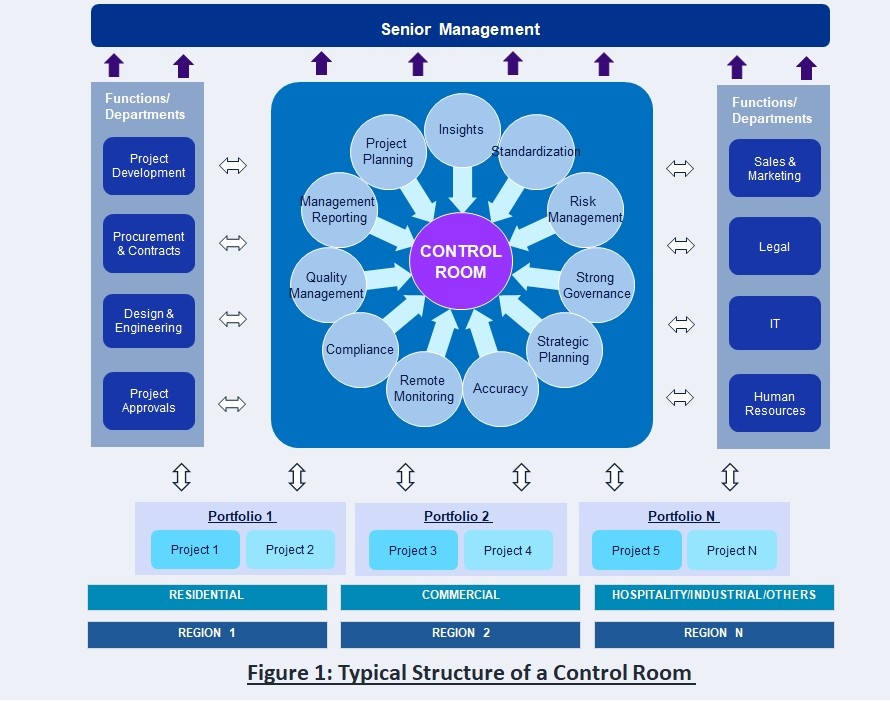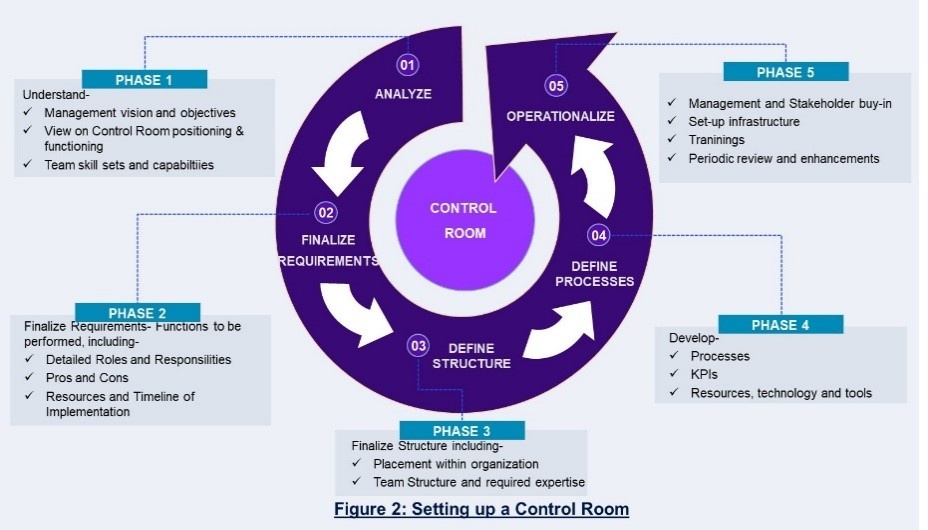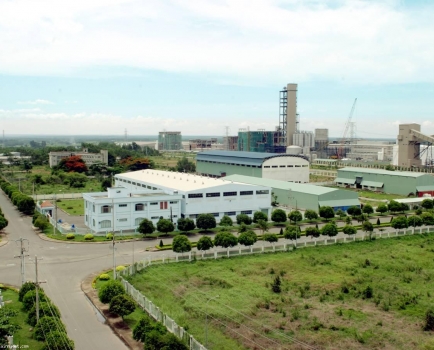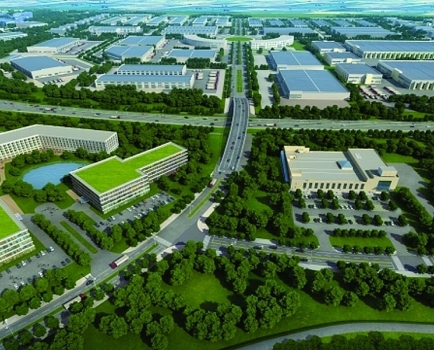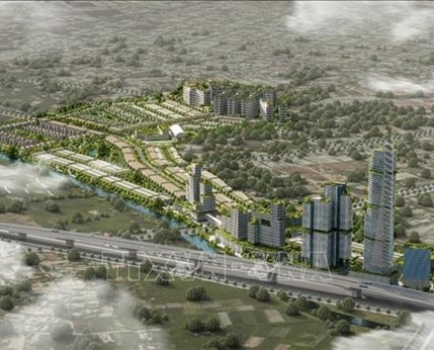Control Room: driving stronger project governance
Wed, 23 Nov 2022 22:10:00 | Print | Email Share:
Control Room – A Centralised, Independent Command and Support Centre for managing a portfolio of projects.
A Control Room is an independent layer of project monitoring and reporting between Senior Management and the execution team and supports in managing the entire portfolio of a company’s projects. A typical Control Room provides management with actionable intelligence while identifying, prioritising, and taking pre-emptive actions on potentially critical issues, hence, minimising impediments in project delivery.
A Control Room standardises project-related governance processes and enables the sharing of methodologies, techniques, resources, and tools between individual projects. Depending on the placement and roles within the organisation, a Control Room may also be called a War Room, Centre of Excellence, Central Planning and Monitoring Team, Project Management Office, or Project Management Unit.
Control Room involvement in an organisation varies based on the objectives it is envisaged to achieve. Accordingly, a Control Room can be a Non-executing or Executing type.
The role of a Non-executing Control Room is primarily focused on the capacity building of the project team and supports it in certain critical functions as required such as planning, budgeting, reporting, and establishing standardised methodologies. Project team members receive training and support from the Control Room but remain fully responsible for the delivery and results of their projects. The degree of control is low to moderate in such a role.
On the other hand, an Executing Control Room is not only responsible for the development of consistent policies and procedures, training, and support, but also for the direct management of one or more projects or functions based on the organisation's requirements and strategies. The degree of control is high in this role.
In Vietnam, select developers – both medium and large – have established such a team with a primary focus on project scheduling, management reporting, and other project management activities and have observed visible benefits in managing projects.
Complexities and risks in project development increase with the number of projects being executed, the varied segments of projects in a portfolio, and the geographical expanse. In such a scenario, a Control Room can help organisations drive stronger governance mechanisms and methodologies.
As an independent layer for monitoring and reporting, the Control Room ensures that all critical issues affecting project progress and asset delivery are being identified objectively and in a timely manner, notified to management, and addressed promptly. It also helps to break inter-departmental silos and streamline functions within an organisation.
Below are the typical objectives while setting up a Control Room:
• Stronger project governance
• Integration of project planning and monitoring
• Consistent reporting with minimal effort
• Reduction in departmental activity delays and streamlining of inter-departmental coordination
• Improvement of people and resource management
• Early identification of issues, risks, and timely reporting to management for appropriate actions
• Improvement of project time and cost estimate accuracy by benchmarking with similar projects
• Lessons learnt, knowledge, and central data management for future projects
It is necessary for organisations to carefully evaluate all the factors before setting up a Control Room as it significantly impacts the likelihood of its success. There is no one-size-fits-all or leading practice for setting up a Control Room as it varies significantly with the organisation's strategy, vision for the Control Room, availability of skill sets, and budget for setting up such a team.
Some of the key takeaways in setting up a control room are:
• It is important to understand the management objectives, vision, mission, operation, and delivery model, as well as the relationships between the departments and the development plan of the organisation for the next 3-5 years, the challenges being faced in the delivery of projects, and the skillsets and capabilities of the team members when coming up with the Control Room's structure and details
• Organisations can consider phasing out the implementation of Control room functions in waves aligned to the organisation's strategy and management vision. This can help to utilise the lessons learnt along the way for a more sustainable and successful implementation
• The placement of the Control Room in the overall organisational structure is one of the critical factors for the success of a Control Room. It should be an independent layer and placed higher in the organisation's structure, reporting to the Board of Directors, Chairman, or C-Suite
• It is important to ensure the Control Room has adequate authority, acceptance, and autonomy to execute its defined functions and work seamlessly with core departments to break the silos as a support team
• It is essential for staff in the Control Room to have enough expertise to manage and run it successfully
The typical functions of a Control Room include project management, management reporting, risk management, standardisation, advisory support, and management consultation. The functions of a Control Room, as well as the extent of its involvement, can vary in every organisation. The Control Room can be assigned a key or a supporting role in one or more of these functions.
The implementation of technology is an important aspect of Control Room setup, though not a must-have component. Organizations can set up a Control Room without implementing any sophisticated tech solutions to start with and gradually bring them in them over time.
Some of the technology adoptions that can support the functioning of a Control Room are project management software, building information modelling, business intelligence, remote monitoring and collaboration technologies, construction material tracking software, and others.
However, it is important for organisations to note that the implementation of these tools is not a must but rather a good-to-have factor.
Real estate project development involves multiple uncertainties due to external factors such as economic conditions, delays in approvals, regulatory changes, and material and labour cost escalations. Controlling these internally by adequately considering mitigations during the planning, estimating, and monitoring of projects is critical to delivering them successfully.
Using a Control Room as a central command and support centre can play an important role in the organisation by improving the accuracy of project estimates, integrating planning and monitoring, reducing cycle times and delivery costs, and identifying issues and risks. It also helps improve resource management, reporting, and the re-use of knowledge on future projects. Hence, with a multi-vendor, multi-asset environment and high-risk projects, a Control Room can prove to be vital for organisations.
Setting up a Control Room effectively and determining the functions it must perform is a critical exercise which will determine its success in an organisation. It is a highly customised exercise and varies greatly based on the objectives, hence there is no industry best practice that can be directly followed – though there are leading practice references available globally as well as in Vietnam which can be considered.
Further, equipping the Control Room with an appropriately skilled team and relevant technology is important to facilitate its operation.
Lastly, strong management messaging and stakeholder buy-in, along with suitable authority, autonomy, and positioning in the overall organisation are critical success factors for Control Room setup.
The views and opinions expressed herein are those of the author and do not necessarily represent the views and opinions of KPMG in Vietnam.
| Khushboo Goyal, director of Building Construction and Real Estate Consulting Services, and Le Duc Anh, assistant manager for Building Construction and Real Estate Consulting Services (left) |
By: Mai Dang/ Vietnam Investment Review
Source: https://vir.com.vn/control-room-driving-stronger-project-governance-98032.html
---------------------------------------------
Same category News :



